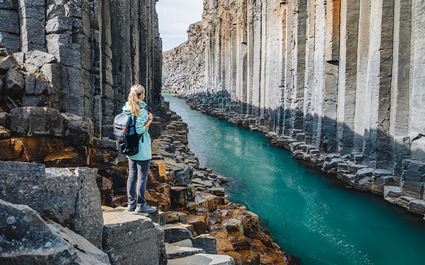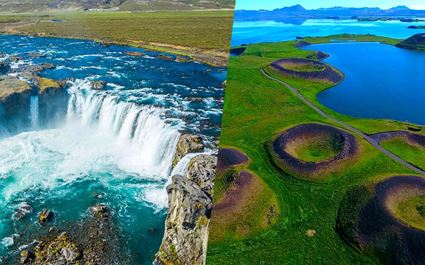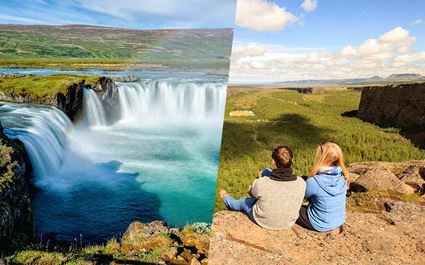Where Are Dimmuborgir Lava Fields Located?
Dimmuborgir Lava Field is located in northeastern Iceland, just east of Lake Mývatn. It is around 6.5 kilometers (4 miles) south of Reykjahlíð, a small village on the lake's edge. The nearest major town is Akureyri, "the capital" of North Iceland; it's about 83 km (51 mi) to the west. Dimmuborgir is a part of the Mývatn-Laxá geothermal area, a popular tourist destination.
How To Get To Dimmuborgir?
Dimmuborgir Lava Fields are easily accessible by car. You would first take Iceland's main highway, the Ring Road (Route 1), and head towards Lake Myvatn. Look out for directions to Reykjahlíð as you get closer to Myvatn. Take Route 848 when you reach Reykjahlíð. Follow Route 848 for approximately 6.5 kilometers (4 miles) until you reach the Dimmuborgir parking area.
General Information About Dimmuborgir
- Location Mývatn, Northeastern Iceland
- Area Size 4.23 km² (1.63 mi²)
- Part of The Krafla volcanic system
- Accessibility Car
- Time to Visit Year-round
- Activities Hiking, sightseeing, photography, stargazing
What Is Dimmuborgir Known For?
Dimmuborgir Lava Field is known for its otherworldly landscapes formed by lava flow. The fields consist of volcanic terrain and lava formations. These unique geological formations include tall columns, hollow chambers, and arched tunnels. Some rock pillars reach heights of over 20 meters (66 feet). These pillars are formed from the cooling and contraction of lava flows, which creates hexagonal columns that are fascinating to observe.
Dimmuborgir has several caves, some large enough to accommodate multiple people. These caves were formed when the lava cooled and solidified around air pockets, creating hollow spaces within the rock. The lava field also features several natural arches, which are formed when two rock pillars come together, creating a bridge. These arches are popular with photographers, offering stunning views of the surrounding landscape.
Despite being a lava field, Dimmuborgir is surprisingly green, with moss and other plants growing in the cracks and crevices of the rocks. This vegetation provides a habitat for birds, insects, and small mammals.

History Of Dimmuborgir
Dimmuborgir lava formations were created by an eruption around 2,300 years ago when molten lava cooled and solidified in a series of pits and chambers. It is believed to have been the biggest eruption in the Mývatn area since the last Ice Age, with a fissure system stretching for 16.5 kilometers (10.2 miles). As the lava flowed, it encountered a wet marsh, causing the water to boil and vaporize. This steam created bubbles in the lava, eventually collapsing, leaving a maze of intricate formations behind.
Wind, water, and ice have shaped these unique formations over time. The wind has polished their surfaces, giving them a smooth, rounded appearance. Water has eroded some caves and arches, creating various shapes and sizes. Ice has also played a role in the landscape, carving out deep crevices and creating jagged edges.
Dimmuborgir is surrounded by Icelandic folklore, with tales of trolls, elves, and other mythical creatures lurking there. Some of them are hostile to humans; others may help lost travelers. Dimmuborgir is said to be hell's entrance, where Satan himself was cast out of heaven. It is also home to the Yule Lads, the mischievous trolls who visit children on Christmas Eve. Good children receive treats, while naughty children are threatened to be eaten by Grýla, the giantess mother of Yule Lads.
Interesting Facts About Dimmuborgir
The name "Dimmuborgir" means "Dark Castles" in Icelandic, referring to the abstract rock formations that resemble a medieval citadel.
Dimmuborgir is part of the Mývatn-Laxá UNESCO Global Geopark, an area recognized for its exceptional geological diversity and volcanic heritage.
The lava field has been used as a filming location for several movies and television shows, including the HBO series "Game of Thrones."

What To Do At Dimmuborgir?
Hike Around
The lava field is easily accessible by well-marked trails, making it ideal for hiking and exploring. The trails wind through the otherworldly terrain, taking you past towering rock pillars. As you hike, you'll appreciate the field's geological uniqueness and the surrounding atmosphere.
Snap Lifetime Photos
Dimmuborgir is perfect for photography, so bring your camera to capture lifetime moments and picture-frame memories. Many visitors try to find the Kirkjan, or "The Church," and take some pictures of it. This imposing rock formation resembles a medieval church with its arched roof and towering spire.

Best Time To Visit Dimmuborgir
The best time to visit Dimmuborgir lava fields depends on your preferences for weather and crowds and what you hope to experience during your visit.
Summer (June to August) is the most popular time to visit Iceland, and Dimmuborgir is no exception. The weather is generally warm and sunny, with average temperatures ranging from 10°C to 15°C (50°F to 59°F). It is a great time to enjoy hiking and exploring the lava fields. However, summer is also the peak tourist season, so expect larger crowds and higher prices.
Spring (April to May) and autumn (September to October) offer a pleasant balance of weather and crowds. The weather is still relatively mild, with temperatures ranging from 5°C to 10°C (41°F to 50°F). There are fewer tourists during these shoulder seasons, so you'll have more space to enjoy the lava fields.
Winter (November to March) is the least popular time to visit Dimmuborgir, but it can be a magical experience. The snow-covered lava fields are a truly enchanting sight, and there are fewer crowds to contend with. However, be prepared for cold temperatures, with average temperatures ranging from -5 °C to 0°C (23°F to 32°F).
Where To Stay Near Dimmuborgir?
- Dimmuborgir Guesthouse is a modern hostel offering comfortable accommodations, a shared kitchen, and a sauna. It's located just a short walk from Dimmuborgir and other attractions in the area.
- Vogafjós Farm Resort is charming, with various accommodation options such as cottages, apartments, and hotel rooms. It's about 10 kilometers (6 miles) from Dimmuborgir and offers outdoor activities such as horseback riding, fishing, and hiking.
- Hótel Laxá is an elegant hotel located on the banks of the Laxá River, just outside of Mývatn. The hotel offers stunning lake views and various activities like fishing and kayaking.
- Berjaya Iceland Hotels is a luxurious stay located just outside Reykjahlíð, offering stylish rooms, a spa, and a restaurant with stunning lake views.
- Hlíð Camping is a campsite just 2.5 kilometers (1.5 miles) from Dimmuborgir and offers a variety of accommodation options, including camping cabins, tents, and camper van pitches.










